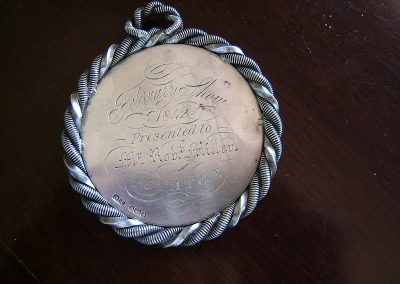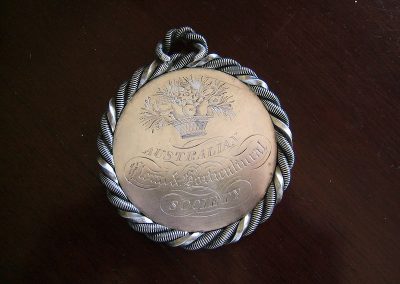The Australian Floral and Horticultural Society
Contributed by Margaret Miller, Member Lane Cove Historical Society
This silver medal was awarded to Robert Miller at the February 1842 Australian Floral and Horticultural Society Show, which he received for his Potatoes.
Robert, his wife Elizabeth and six children came from Paisley, Scotland, arriving on the ship Othello in March 1834. After spending some time in Sydney, the family moved to the New South Wales south coast and, in 1842, were living on his property Renfrew Park at Gerringong. Three more children were born to the couple after their arrival and generations of Robert’s descendants have carried on the dairy farming tradition in the area.
About the Australian Floral and Horticultural Society
The Australian Floral and Horticultural Society came into existence in May 1838 when a group of Sydney gentlemen, desirous of encouraging the production of good quality fruit and vegetables in the colony, met at Mr Green’s Cricketers Arms at the corner of Pitt and Market Streets, Sydney for the purpose of establishing a horticultural society. [1] They followed up with a second meeting at Mr Green’s where the rules of the society were laid down and officers of the society appointed. [2]
It was planned to hold three shows of flowers, fruits and vegetables each year and the first was held in September of that year in the rooms of Mr T.W. Smart of George Street. Following the judging, members of the public were given the opportunity to purchase tickets to view the exhibits; a further source of income to add to the annual membership fee of £1 paid by members of the society. [3]
The second show in February 1839 was moved to the saloon of the Royal Hotel and the value of prizes increased; a silver cup to the value of £10 was to be awarded for the best sample of wine grapes, and other prizes to the amount of £20 for the best specimens of flowers, fruits and vegetables. [4]
The society held its first Annual General Meeting in July 1839 at the Royal Hotel. [5] The members met again soon after at Mr Webb’s in York Street to plan the first show for the season which was to be held in the Market Place, George Street. [6] The bigger venue no doubt a sign of the show’s increasing popularity. In its first Annual Report the society declared that the encouragement and support attained had firmly established the society. [7]
For the February 1840 show the scope of exhibits was expanded to include the category of best colonial wine. A silver cup was the award for the best type of grape adapted to the manufacture of wine, and silver medals were to be given for the best grapes of different descriptions. [8] Also included was a prize for the best sample of colonial manufactured tobacco. The whole of Section A of the Market Building in George Street was leased for the coming exhibition. [9] So successful were the shows that exhibitions were extended to run over three days. [10]
A year later the Society was offering prizes to the value of £100 at its February show; a gold medal value 12 guineas for the best sample of wine from grapes grown in the colony, £40 for finest or best flavoured fruits, £10 for cider or perry manufactured entirely from fruits grown in the colony, £20 for best flowering shrubs and florist’s flowers, £10 for tobacco manufactured entirely from leaf grown in the colony, and £20 for the finest or best vegetables. [11]
The popularity of the three annual shows continued and in 1845 it was decided to go further afield and hold an exhibition at Parramatta in November. The exhibition, governed by the usual regulations, was held at the rooms of Mr McKay, the Australian Arms on Wednesday 19th. [12]
When it came to booking the Market Building in George Street for the February 1846 exhibition demands made by the lessee prevented the booking and the show was held at the Royal Hotel. [13] However, by October they were back at the Market Building for their spring exhibition. The show was visited by his Excellency the Governor, Lady Mary Fitzroy, Sir Maurice O’Connell and family, the Right Worshipful the Mayor, and a large portion of the most respectable citizens. The Band of the 11th Regiment was in attendance, and as usual the building was very tastefully ornamented with flowers and evergreens. Among the many exhibits were articles of colonial produce – olive oil, bone manure, phosphorus and iodine, and a prize was awarded for silkworms. [14]
The 1847 Annual Meeting of members, held at Mr Richard Driver’s Three Tuns Tavern on the corner of King and Elizabeth Streets, celebrated the society’s growth over the past nine years. The Secretary reported that the society had never retrograded nor even been stationary but had always progressed in regard to the number of members and the number and variety of fruits, plants, flowers and vegetables exhibited, the cultivation of which was now becoming an object of more general interest among the colonists. This applied to plants of commerce which they hoped would, in a few years, become one of the staple exports of New South Wales, second in importance only to those of wool and tallow. [15]
By October 1849 the popularity of the exhibitions had waned with the spring exhibition receiving a shabby share of patronage. However, the Sydney Morning Herald was quick to defend the society pointing out that the exhibits were superior to any before exhibited in the colony and this was mainly attributed to the strenuous exertions of the society to promote a love of the art of gardening, the society’s objectives having been more fully and beneficially carried out than those of any other cognate society in the colony, and if the society be somewhat on the decline, it had accomplished its original objectives. [16]
How long the Australian Floral and Horticultural Society continued to function remains to be discovered, but from 1850 onwards a number of new organisations of a similar nature sprang up in Sydney. However, in an article on ‘Tea Culture in Australia’, published in 1872, the Australian Town and Country Journal made reference to the society’s demise – ‘On one occasion at least, somewhere about a quarter of a century ago a pound or so of Sydney grown and Sydney prepared tea of a fair usable quality and marketable appearance, was exhibited at a horticultural fete, held in the old Market-Place, George Street, under the auspices of the Australian Floral and Horticultural Society, then the most successful, and at its demise, the longest-lived society of the kind that has either before or since existed in New South Wales’. [17] The Australian Floral and Horticultural Society had by then run its course.
References:
[1] Commercial Journal and Advertiser, Sat 12 May 1838, p.2.
[2] Sydney Gazette and New South Wales Advertiser, 17 May 1838, p.2.
[3] Commercial Journal and Advertiser, 12 Sept 1838 p.1.
[4] The Australian, 10 Jan 1839, p.3.
[5] The Sydney Herald, 26 June 1839, p.1.
[6] The Sydney Monitor and Commercial Advertiser, 13 Sept 1839, p.1.
[7] South Australian Record (London, England), 1 Feb 1840, p.3.
[8] The Sydney Herald, 6 Jan 1840, p.2.
[9] The Australian, 1 Feb 1840, p.1.
[10] The Sydney Herald, 4 Dec 1840, p.4.
[11] Free Press and Commercial Journal, 30 Jan 1841, p.4.
[12] The Sydney Morning Herald, 18 Nov 1845, p.1.
[13] The Sydney Morning Herald, 16 Feb 1846, p.1.
[14] Sydney Chronicle, 3 Oct 1846, p.2.
[15] The Sydney Morning Herald, 1 Jul 1847, p.2.
[16] The Sydney Morning Herald, 18 Oct 1849, p.2.
[17] Australian Town and Country Journal, 6 Jul 1872, p.17.


